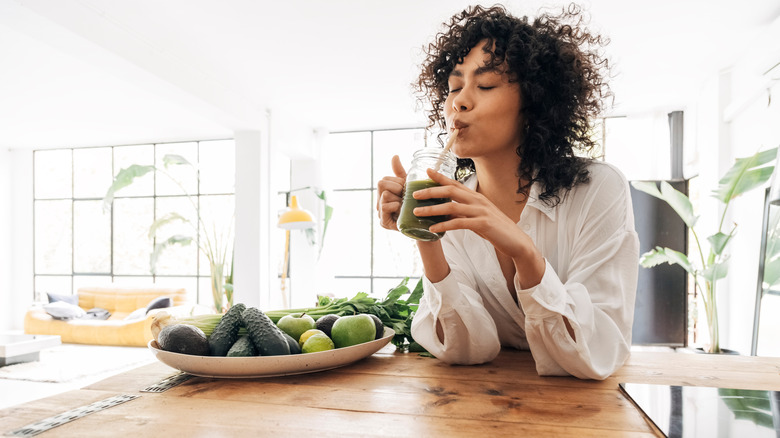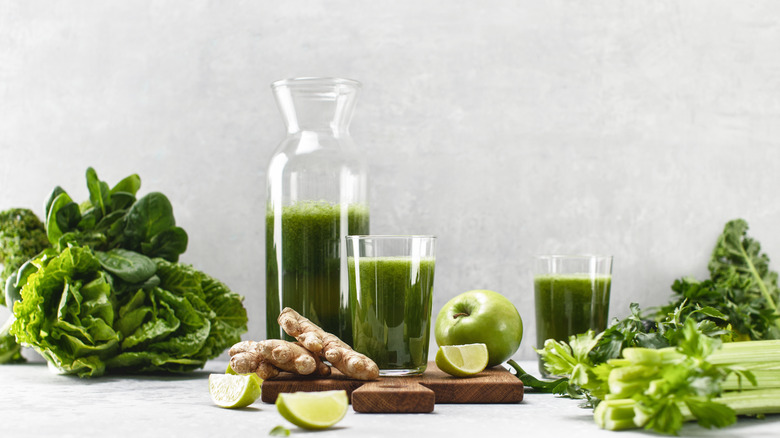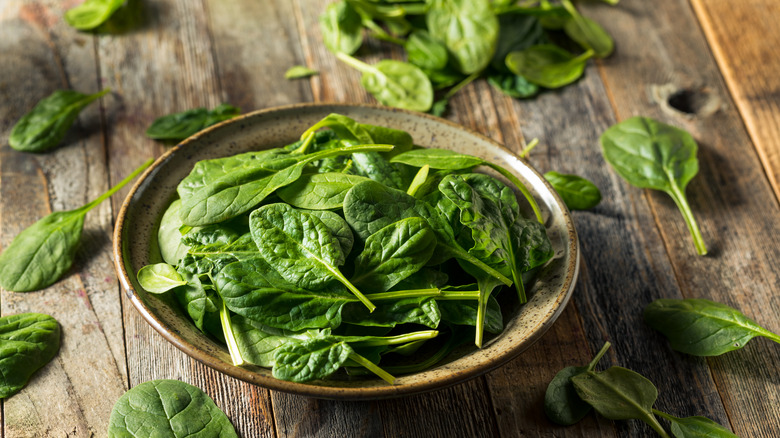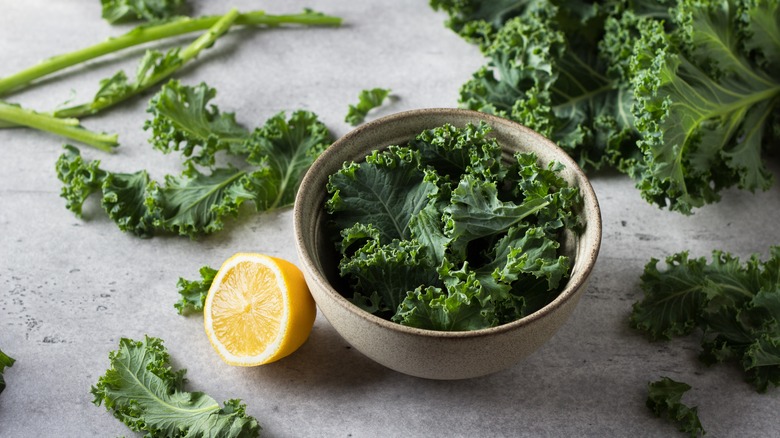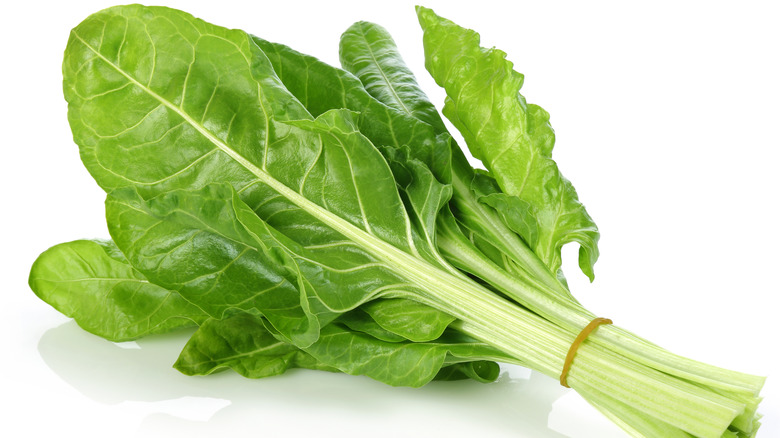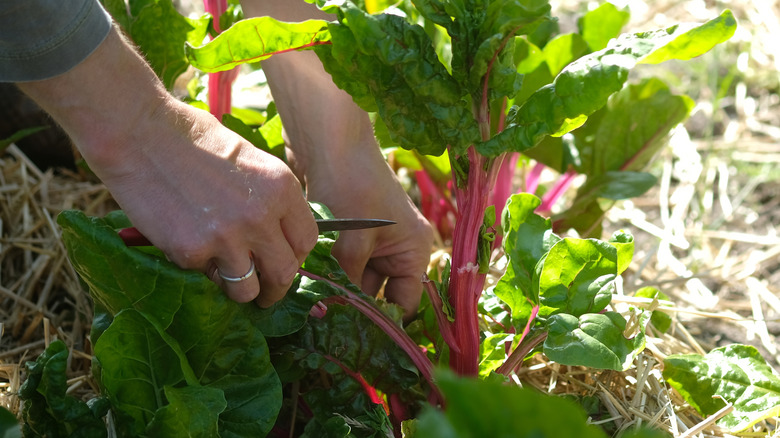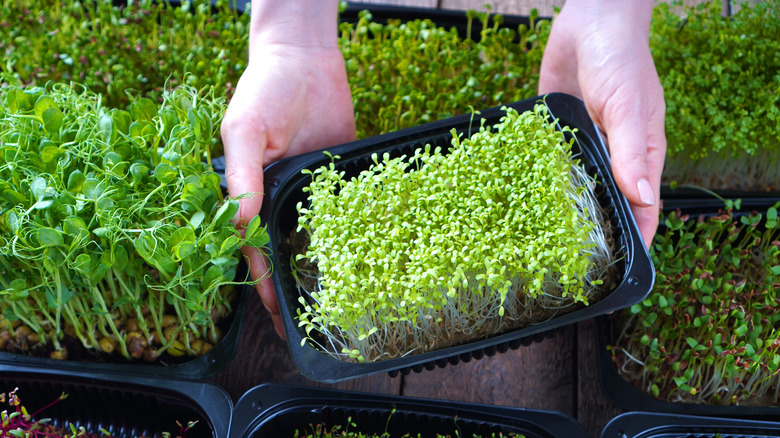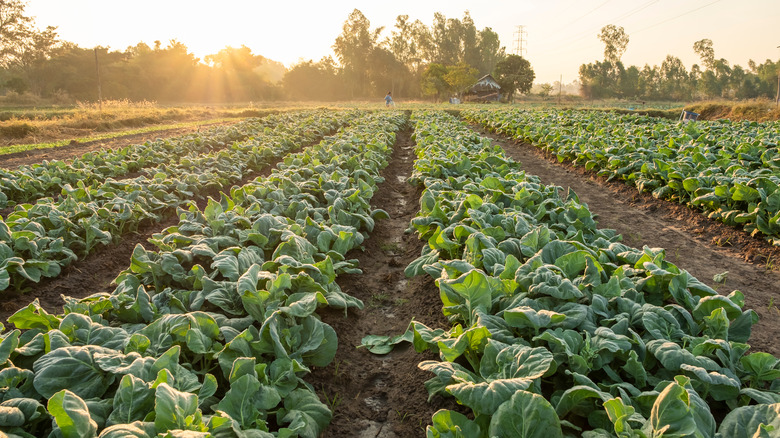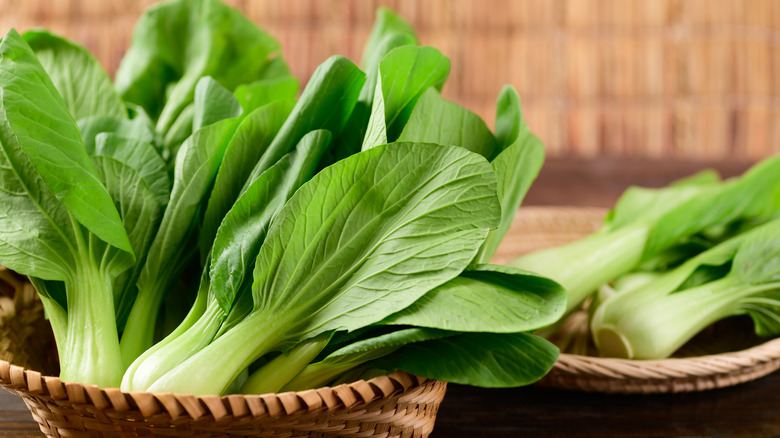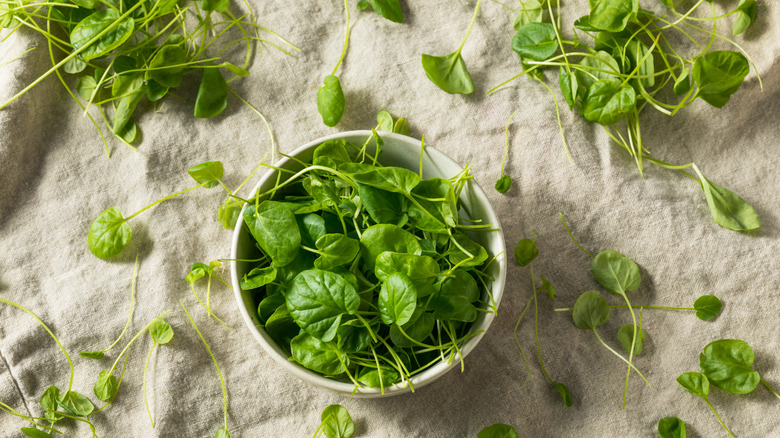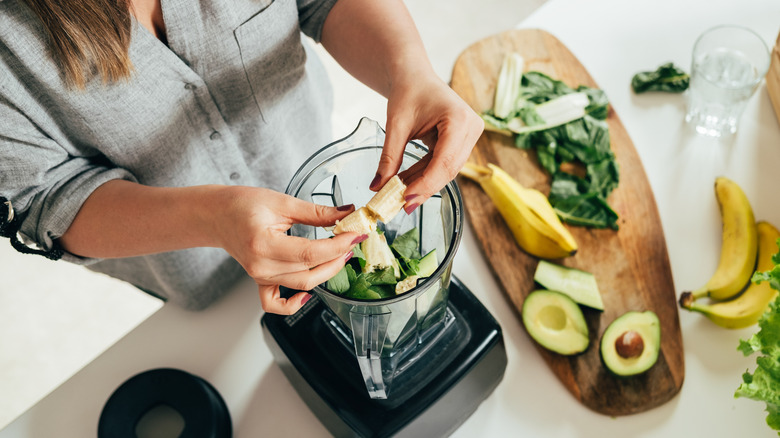Healthy Greens That Belong In Your Smoothie
Everyone knows how healthy vegetables are, yet few people are getting enough in their daily diet. According to the Centers for Disease Control and Prevention (CDC), only 10% of adults in America consume the recommended 2 to 3 cups of fruits and veggies a day. Meeting these recommendations can improve the health of your heart, eyes, and digestive system and reduce the risk of cancer (via Harvard T.H. Chan School of Public Health). Eating plenty of fresh veggies can also help you maintain your weight.
But with today's hectic schedules and easy access to fast food, taking time to prepare and eat fresh foods every day may not be a priority for many people. That's where smoothies come in handy. With five minutes and a blender, you can pack in almost all of your daily recommended vegetable servings. Put it in a to-go cup and you don't even have to sit down for a meal.
Love 'em or hate 'em, leafy greens can be a key ingredient in a healthy smoothie (via Clean Eating Kitchen). If you don't like the taste of greens, blending them with fruits and other ingredients is a great way to mask the flavor. As far as variety goes, you've got lots of options, each one offering a different flavor and nutritional profile.
What's so great about greens?
Leafy greens — especially dark leafy greens — are nutrient powerhouses. They're especially rich sources of vitamins A, C, K, and folate, nutrients that can help reduce inflammation, protect your bones and eyesight, and boost your immune system (via Montana State University). Leafy greens are rich in fiber — a type of carbohydrate that is important for digestive and heart health — and they're also a good source of plant-based protein (via the Mayo Clinic and Journal of Geriatric Cardiology). Combined with their lower calorie count, this makes them an ideal food if your goal is to lose weight.
When it comes to fighting cancer, leafy greens lead the battle due to their high content of antioxidant compounds such as carotenoids, according to the U.S. Department of Agriculture (USDA). These helps to neutralize free radicals, preventing cell mutations that can cause cancer (via Harvard Health Publishing). For example, a 2021 study published in nutrients found that a diet rich in leafy greens was able to lower oxidative damage in adults with an increased risk of colorectal cancer. The USDA states that 2-3 servings a week can provide this protective effect against a number of different cancers.
Oxidative stress can also compromise brain function, and leafy greens can help with that too. A study published in 2018 in Neurology concluded that eating 1 cup of leafy greens each day can slow cognitive decline associated with aging.
Spinach
Popeye's favorite food is a smoothie staple. Its mild flavor plays nice with a host of popular smoothie ingredients, giving you endless flavor options (via Sweetwater Organic Community Farm). Just 3.5 ounces of fresh leaves pack in almost 3 grams of protein, a little over 2 grams of fiber, and nearly 3 grams of iron (via My Food Data). Spinach is one of the richest plant sources of iron, a mineral that your blood needs to carry oxygen throughout your body (via American Red Cross and National Institutes of Health).
Spinach may play an important role in heart health. According to a 2012 study in Free Radical Biology & Medicine, spinach contains a compound called nitrite that can acutely lower blood pressure and enhance endothelial function. The endothelium is a membrane lining the heart and blood vessels. It releases cells that control vascular contraction and relaxation and enzymes that help with blood clotting and immune function (via Cedars Sinai). Additionally, like other leafy greens, spinach is packed with cancer-fighting antioxidants. Specifically, it has high levels of sulfoquinovosyl diacylglycerol (SQDG) and monogalactosyl diacylglycerol (MGDG), compounds which can inhibit cancer cell growth, according to Bioactive Foods in Promoting Health.
Spinach is one of the most convenient smoothie greens, because you can find it in the frozen foods section. Throw in a cup or two of frozen leaves — no washing or chopping required (via Wholefood Soulfood Kitchen).
Kale
Kale is a hearty leafy green belonging to the cruciferous vegetable family that also includes broccoli, cauliflower, Brussels sprouts, collard greens, watercress, arugula, cabbage and more. These vegetables share common nutritional benefits, such as high contents of vitamin K and the B vitamin folate (via Eat Right). According to the National Institutes of Health (NIH), vitamin K is necessary for blood clotting and bone health, and folate is required for your body to make DNA and other genetic material. Folate is a key nutrient women need before and during pregnancy for preventing birth defects.
If getting more fiber is your goal, grab some kale for your smoothie. A 3.5-ounce serving has more than 4 grams of fiber, which is 13-15% of the daily recommended intake for adults (via the USDA and UCSF Health). Getting enough fiber is key for digestive health, as it helps move food through the digestive tract and prevents constipation, according to the Mayo Clinic. It also helps remove "bad" LDL cholesterol from the body. In addition, fiber doesn't provide any calories, but its bulk fills you up. Eating a diet high in fiber can help you control your appetite for weight loss.
Kale has a tougher consistency than spinach and some other leafy greens, so it might need some extra blending (via Lettuceinfo.org). You'll only want to blend the leaves, so be sure to remove the stems first (per Eat Right).
Swiss chard
Like kale, Swiss chard is a cruciferous vegetable. It has a milder flavor and softer texture than kale, but still packs all the same nutritional benefits (via Kitchn). Swiss Chard is rich in vitamin K (per USDA), promoting healthy blood clotting and reducing your risk of osteoporosis (via NIH). It's also an excellent source of vitamin A, providing one-third to one-half of the Recommended Daily Allowance (RDA) in a 3.5-ounce serving of raw leaves (via NIH). Vitamin A is a fat-soluble nutrient that is best known for promoting healthy vision, and it also plays an important role in immune function and organ health.
If you need a mood boost, chard may be able to help. According to a 2018 study in World Journal of Psychiatry, cruciferous vegetables such as Swiss chard are one of the richest food sources of nutrients that can help prevent and treat depressive disorders. These include folate, iron, long-chain omega-3 fatty acids (EPA and DHA), magnesium, potassium, selenium, thiamine, vitamin A, vitamin B6, vitamin B12, vitamin C, and zinc. Of these nutrients, Swiss chard is an especially good source of vitamins A and C, magnesium, potassium, and iron (per USDA). Note that the chard's stem and any large ribs should be removed before blending (via Kitchn).
Beet greens
Many people may not know that the leafy tops of the beet root are edible. The sweet and mild flavor of beet greens (via Epicurious) makes them perfect for sneaking greens into a smoothie. And while their flavor might be unassuming, their nutrient profile is a standout. Authors of a 2019 article in Natural Food Therapy rated the nutrition of foods according to 20 different rankings. Beet greens received 11 "excellent" ratings and six "very good" rankings, and placed in the top 10 most nutritious foods. In fact, beet greens are even more nutrient-dense than spinach and kale, offering greater amounts of fiber, calcium, and potassium (via MyFoodData).
While you're at it, throw in the root as well. The deep red color of the root comes from betalains, a phytonutrient offering antioxidant, anti-inflammatory, and detoxification benefits (via Northwestern Medicine). According to a review in Phytotherapy Research, recent studies show that betalains in red beetroot can also lower blood pressure and cholesterol, and provide benefits for diabetes and obesity.
There's no need to cook beet greens or the root before blending it in your smoothie (via University of Illinois Urbana‐Champaign). Just be sure to scrub the root well, and peel off the tough skin first (via Best Food Forward).
Microgreens
Microgreens are the immature seedlings of a variety of fruits and vegetables, from leafy greens like arugula and watercress to melons and cucumbers (via Healthline). Their flavor ranges from sweet to spicy, depending on the plant (via Microgreens World). Kale and sunflower greens tend to have a sweeter flavor that works well in smoothies, but any type of microgreen is a good choice due to their concentrated amounts of certain nutrients.
Microgreens are an especially rich source of plant-based iron. Just 1 ounce of a sunflower and beet microgreens mix has 120% of the daily value (DV) for iron (via My Food Data). Compare that to an ounce of mature spinach or kale, which has just 3-4% of the DV. According to the NIH, iron deficiency isn't uncommon among women under age 50, pregnant women, and vegetarians. Iron deficiency anemia occurs when your body's iron stores get too low. Your red blood cells shrink in size and can't carry as much oxygen from the lungs to the rest of the body. Symptoms of iron deficiency anemia include fatigue, weakness, lack of energy, gastrointestinal distress, and poor memory and concentration. It can also lower your body's resistance to germs and infections.
Ounce for ounce, microgreens are also better sources of protein, fiber, potassium, phosphorous, magnesium, selenium, and vitamin C. Some types, such as pea greens, are rich in omega-3 fatty acids, which are an important nutrient for supporting cognitive and cardiac health (via The Terrace Foundation and NIH).
Dandelion greens
Dandelions aren't just annoying weeds — they can be a nutritious addition to your smoothie. Dandelion has been used medicinally in China and India for hundreds of years to treat liver diseases and digestive problems (via NIH). The leaves have also been used traditionally as a diuretic, as an appetite stimulant, and to detoxify the liver (via Mount Sinai). Not all of these uses have been proven in scientific studies. However, it's clear that dandelion leaves do have potentially powerful benefits for health. According to a 2019 review in Phytochemistry Reviews, in vitro and in vivo research has shown dandelion to have antibacterial, anti-inflammatory, antiviral, cytotoxic, diuretic, and liver-protective effects, although more research needs to be conducted to determine the scope and viability of dandelion as a medicinal food.
Ounce for ounce, dandelion greens have a similar nutrition profile to spinach and kale, offering the same amounts of protein, fiber, iron, potassium, and calcium (via My Food Data). Like many other leafy greens, dandelion greens contain a high amount of vitamin A, with just 1 ounce providing almost 100% of the DV. They're also an excellent source of vitamin K.
The best part is you can often get them for free in your own back yard. That said, use caution. Many people treat their lawns with pesticides that can be toxic when ingested. Unless you're sure your yard is pesticide-free, it's probably best to buy them at a local market (via The Independent).
Collard greens
Collard greens are popular in southern cooking, typically braised for hours with pork fat and other unhealthy ingredients (via Southern Living). But they can also be eaten raw in salads and smoothies for a boost of flavor and nutrition. Collard greens are another member of the cruciferous vegetable family, and are a good source of plant-based protein, fiber, potassium, and vitamins A, C, and K (via the USDA).
The mineral calcium is where collard greens really stand out. Just 3.5 ounces of raw collards provide 20% of the daily recommended amount for adults ages 19 to 50. Indeed, according to My Food Data, collard greens are the top vegetable source of calcium — so for those who don't eat dairy products, eating collard greens is a good way to meet daily calcium needs. Calcium is crucial for healthy bones and teeth, as well as muscle function and nervous system health. According to the NIH, many Americans don't get enough calcium, which can lead to osteoporosis — a condition in which your bones become fragile. This is especially important for older adults, as osteoporosis can increase the risk of falls and fractures.
Collard greens have a mild taste, with a subtle smokiness (via the Florida Department of Agriculture and Consumer Services). The tough stems should be removed, and Clean Eating Kitchen recommends steaming them for a couple minutes as well before blending, though this isn't strictly necessary.
Bok Choy
Crunchy and mild-flavored, bok choy is a smoothie superstar (per The Fresh 20). Also known as Chinese cabbage, it's a cruciferous vegetable that offers all the nutritional and antioxidant benefits of other leafy greens — and then some (via WebMD). In fact, bok choy came in second in the CDC's ranking of powerhouse fruits and vegetables. Powerhouse vegetables are those that supply the highest amounts of 17 nutrients determined by the Food and Agriculture Organization of the United Nations and Institute of Medicine to be of importance to public health. Bok choy beat out chard, beet greens, and spinach, which occupied the third, fourth, and fifth spots.
When choosing bok choy, you might notice there are two different sizes: baby and regular. Baby bok choy, also called Shanghai bok choy, has a milder and sweeter flavor, according to Cook's Illustrated, which may make it a better choice for a smoothie. Whichever one you choose, you don't have to remove the white stalks before blending (per Healthline).
Watercress
Wondering which vegetable took the top spot on the CDC's powerhouse vegetable ranking? Watercress! Also a cruciferous vegetable like bok choy, Swiss chard, and kale, watercress is low in calories and carbs and high in important vitamins and minerals such as vitamins A and K, potassium, phosphorus, and calcium (via the USDA).
According to an article in Evidence-Based Complementary and Alternative Medicine, watercress is used in traditional medicine as an established remedy for high cholesterol, high blood sugar, high blood pressure, arthritis, bronchitis, and toothache. Its therapeutic effects are attributed to plant compounds such as isothiocyanates, glucosinolates, polyphenols, B vitamins, and vitamin C. Watercress may also be an important functional food for fighting cancer. In a 2007 study in the American Journal of Clinical Nutrition, study participants who ate 85 grams of watercress daily for eight weeks had reduced DNA damage and significantly increased levels of antioxidants in their blood, both of which can reduce the risk of cancer. The effect was more significant in smokers than non-smokers.
With its peppery flavor, watercress can be an acquired taste and it may not be your first choice in a smoothie . However, blended with the right ingredients you can create a drink that packs a punch, both flavor-wise and nutritionally.
Green smoothie inspiration
Knowing that greens are good for you is easy; the hard part comes when you try to add them to smoothies. To a certain extent, it takes a bit of trial and error to get the flavor and consistency right. And, it can vary from person to person, depending on their tastes. But here are a few tried-and-true recipes to get you started:
Spinach smoothie: Combine and blend two handfuls of fresh spinach, half an avocado, the flesh of one fresh mango, one banana, and 2 cups of milk and blend until smooth. You can use equivalent amounts of frozen spinach and mango in place of fresh (via BBC GoodFood).
Kale smoothie: Combine two handfuls of chopped kale, one-half avocado, the juice of one-half lime, a handful of frozen pineapple chunks, a medium-size chunk of ginger, 1 tablespoon of cashews, and one banana (optional). Blend until smooth (via BBC GoodFood).
Watercress smoothie: Blend 1 cup of raw watercress, four mint leaves, one-fourth avocado, one green apple, half a banana, and 1 1/2 cups coconut milk (via Nutribullet).
Bok choy smoothie: Combine and blend two heads of baby bok choy (bases cut off), one cup mango, a few pineapple cubes, one banana, 1 cup plain coconut milk, a pinch of cinnamon, and 2 cups of water (via Go Dairy Free).

